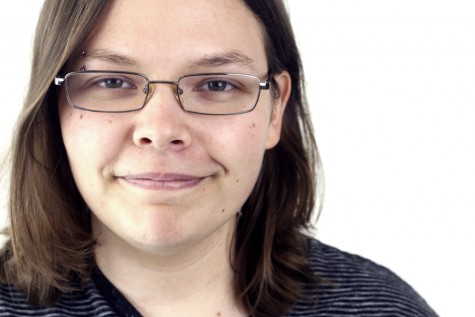Variety of media make Grad Exhibit worthwhile
April 23, 2015
With many pieces playing on themes of death, decay and man’s role in nature, the 2015 Graduate Art Exhibition prompts viewers to contemplate life from different viewpoints.
This exhibit displaying the works of nine graduate students will come to a close on Sunday, and those who have not yet had a chance to walk through the Main Galleries of the Tarble Arts Center should take the opportunity to do so this weekend.
Most of the works are mixed-media sculptures, while others incorporate audio and video, sketches and paintings, printmaking techniques and photographs.
The variety of media allows viewers to have multifaceted interpretations of the content of this exhibit as they walk through the gallery and experience each piece in a distinct way.
Works from Annie Cunningham offer a unique perspective by juxtaposing living and dead bits of nature.
Her “Life on Death” sculptures feature organic matter such as animal bones and sticks with vibrantly colored crystals growing off them.
The crystals vary in color from bright orange and yellow to teal, some with an almost moldy appearance.
Seeing something so colorful growing off of what appears to be a jawbone, vertebrae and other dead things makes for an interesting contrast and perspective on life and death.
Another set of Cunningham’s sculptures is a series of faces made of gray and brown shades of plaster.
All of the faces have a fossil-like appearance, as if the rocks grew around them, and they have clumps of crystals coming out of their eyes and mouths.
Those who appreciate art that presents something visually beautiful in a morbid fashion will likely find these works intriguing.
A different type of display is Ryan Paluczak’s “Short Circuit Lullabies,” which features a series of aluminum rectangles with images printed on them in ink and circuit boards in the center playing a lulling guitar loop.
The audio aspect of this piece adds to the experience of viewing it; one image has a demonic goat head attached to a naked human body, while others include cartoons, faces, skulls, geometric patterns and blotches.
The soothing notes entice viewers to linger around this display to consider each individual drawing and how the images paired with the sound affects their mood.
One piece by Rindy Ricketts has three hanging antique windows, all with notable signs of deterioration, and they all are at right angles to one another forming a sort of invisible room, with final wall being paper drawings of similar images.
Ricketts’ display is another example of the theme of decay being incorporated into artwork, but this one uses the alternate concept of parts of the buildings humans live in to do so.
Another piece that would be considered a mixed-media sculpture is Jamie Lovell’s series of interwoven yarn that appears to be drooping from the walls in various shapes.
Some shapes are dark black while others are bright red, and they all have spots of paint soaked into them.
One of the sculptures within this display resembles an extended leg and is titled “Why the F— am I Here?”
This display has a very loose structure and gives the sense of releasing control or of being set free.
Many other displays in this exhibit would be worth viewing and meditating on their meanings as well.
Collectively, the pieces from Eastern’s graduate art students show a reflection on complex yet universal ideas.
Stephanie Markham is a junior journalism major.
She can be reached at 581-2812 or samarkham@eiu.edu.


















![[Thumbnail Edition] Senior Foward Macy McGlone, getsw the ball and gets the point during the first half of the game aginst Western Illinois University,, Eastern Illinois University Lost to Western Illinois University Thursday March 6 20205, 78-75 EIU lost making it the end of their season](https://www.dailyeasternnews.com/wp-content/uploads/2025/03/WBB_OVC_03_O-1-e1743361637111-1200x614.jpg)



















































